Figures & data
Table 1. Patient demographic characteristics
Table 2. Post-acute normovolemic hemodilution characteristics
Table 3. Allogeneic blood and blood components transfusion data
Figure 1 Graph is showing hemoglobin (Hb) concentrations in the group treated with Perftoran (PFC group, n = 15) and in the Control group (n = 15) during the preoperative (t = 0), post-ANH (t = 20), and throughout the intraoperative (t = 20 to t = 200). Significant differences were observed between both groups (*p < 0.05). Each point represents mean ± SD.
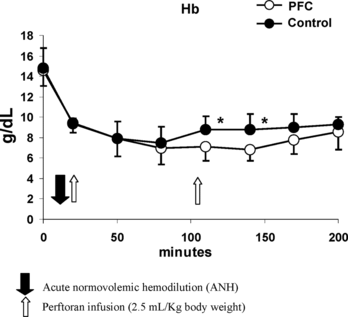
Figure 2 Graph is showing PaO2 during the intraoperative (t = 20 to t = 200). Patients received a FIO2 of 1.0. Control group represents patients with standard of care. The PFC group represents patients treated with Perftoran. After each one of the two Perftoran infusions, significant increments in PaO2 in the PFC group were observed (*p < 0.05). Each point represents mean ± SD.
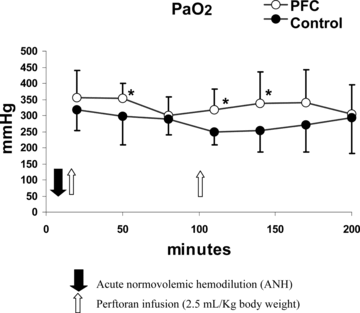
Figure 3 Graph is showing PaCO2 in the group treated with Perftoran (PFC group) and in the Control group during the preoperative (t = 0), post-ANH (t = 20), and throughout the intraoperative (t = 20 to t = 200). Significant differences between the groups were observed only at 200 minutes (*p < 0.05). Each point represents mean ± SD.
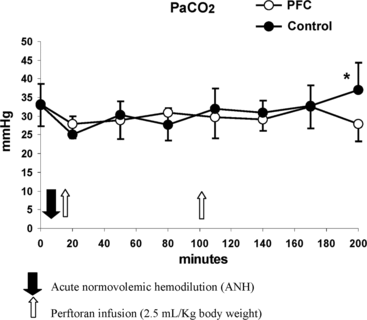
Figure 4 Graph is showing blood pH during the preoperative (t = 0), post-ANH (t = 20) and throughout the intraoperative (t = 20 to t = 200). Control group (n = 15) represents patients with standard of care. PFC group (n = 15) represents patients treated with Perftoran. Each point represents mean ± SD. *p < 0.05 PFC group vs. Control group.

Figure 5 Time course of lactate blood values during the preoperative (t = 0), post-ANH (t = 20), and throughout the intraoperative (t = 20 to t = 200) in patients treated with Perftoran (PFC group) and in patients with standard of care (Control group). Although lactate values were higher most of the time in the PFC group than the Control group, the differences were not statistically significant. Each point represents mean ± SD.
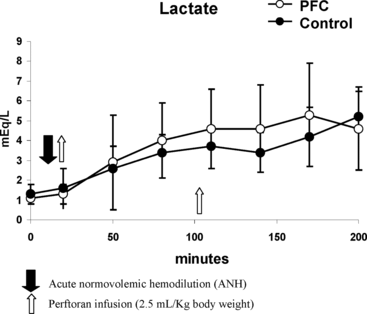
Figure 6 Time course of bicarbonate (HCO3) blood levels during the preoperative (t = 0), post-ANH (t = 20), and throughout the intraoperative (t = 20 to t = 200) in patients treated with Perftoran (PFC group) and in patients with standard of care (Control group). Each point represents mean ± SD. *p < 0.05 among groups.
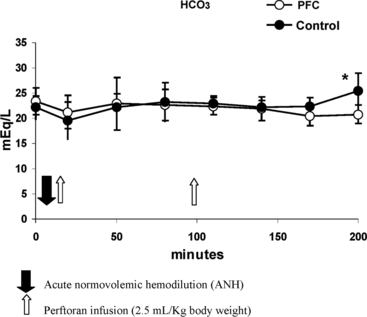
Figure 7 Graph showing base excess in blood in patients treated with Perftoran (PFC group, n = 15) and in patients with standard of care (Control group, n = 15) during the preoperative (t = 0), post-ANH (t = 20) and throughout the intraoperative (t = 20 to t = 200). Although there were differences in the levels of base excess between the groups, these were only statistically significant at 200 min (*p < 0.05). Each point represents mean ± SD.
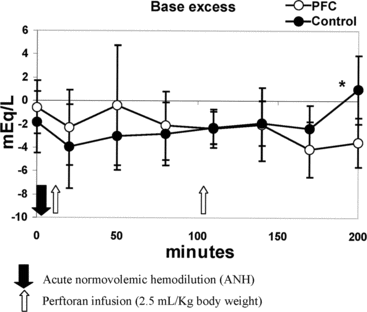
Table 4. Intraoperative characteristics
Table 5. Hematological parameters in the preoperative and the postoperative
Table 6. Preoperative and postoperative coagulation parameters
Table 7. Preoperative and postoperative blood chemistry parameters